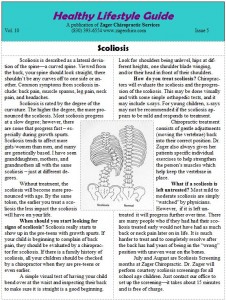Scoliosis
Scoliosis is described as a lateral deviation of the spine – a curved spine. Viewed from the back, your spine should look straight, there shouldn’t be any curves off to one side or another.
Common symptoms from scoliosis include: back pain, neck pain, muscle spasms, leg pain, and headaches.
When should you look for scoliosis?
When should you start looking for scoliosis signs? Scoliosis really starts to show up in the pre-teens, because as a growth spurt starts the inequities in the spine begin to show up. A simple visual test of having the child bend over at the waist and inspecting their back to make sure it is straight is a good beginning. Look for shoulders being unleveled, hips at different heights, one shoulder blade winging, and their head not over their pelvis. If your child is beginning to complain of back pain, they should be evaluated by a chiropractor for scoliosis. If there is a family history of scoliosis, your children should all be checked by a chiropractor when they are pre-teens or even earlier.
How do you treat scoliosis?
Chiropractors will evaluate the scoliosis and the progression of the scoliosis. This may be done visually and with some simple orthopedic tests, and it may include x-rays. For young children, x-rays may not be recommended if the scoliosis appears to be mild and responds to treatment. Chiropractic treatment consists of gentle adjustments (moving the vertebrae) and then specific individual exercises to help strengthen the person’s muscles to help keep the vertebrae in place.
For more information and for the full text of the Scoliosis article, click the link below.

